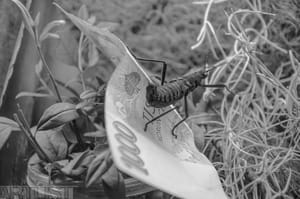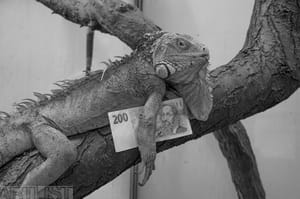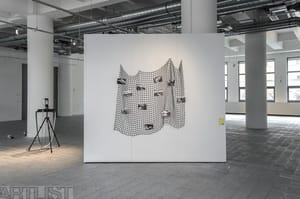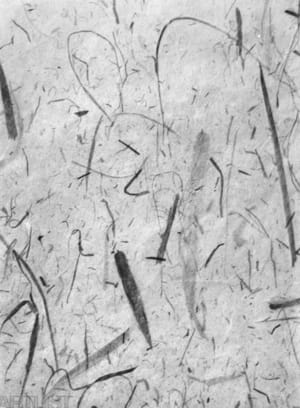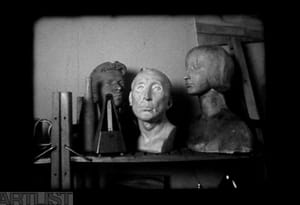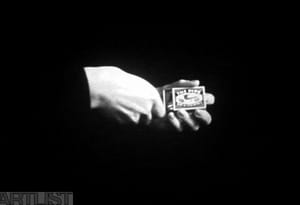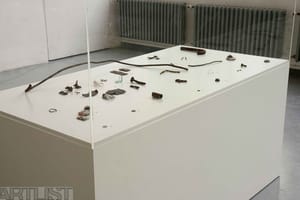- First Name
- Dominik
- Surname
- Gajarský
- Born
- 1986
- Birth place
- Havlíčkuv Brod
- Place of work
- Praha
- Website
- dominikgajarsky.com
- CSU Library
- ↳ Find in the catalogue
About artist
Dominik Gajarský belongs to the youngest generation working on the contemporary Czech art scene. His work is not strictly anchored in one technological medium and he has managed to create a highly individual expressive language in terms of both form and content. The form of his works revolves around black-and-white images that allude to the discourse of modernist photography. In a subjective way that nevertheless references history he charts events of the cultural past. However, the results are not simply research outputs but form the structure for the creation of visual relationships.
The installation Přijde kostra na akádu / The Skeleton Comes to the Academy (2011) is an archaeological activity in which a scientific approach predominates. Along with Tomáš Hrůza and Roman Štětina, Gajarský offers his impressions of the school environment. Using a metal detector they dug up a showcase in the garden of the Academy containing various items. The oldest archival drawings dating back to the beginning of the 19th century and photographs of later installations by freshly graduating students comprised the structure of fragments of different times. The critical force was restricted to the viewer’s ability to assemble these times into a whole.
The inspiration of modern photography is clear in the series Backsides (2012), in which Gajarský draws upon nudes by the American photographer Man Ray by shooting the same motifs from behind. A retrograde perspective opens up that can be appreciated both for its stylistic quality and its connotations to the relationship with modernism. The series Album of a White Man (2013) can at first sight seem like minimalist painterly abstraction. However, these are photographs of replicas of primitive sculptures swimming against a black background. Primitivism was one of the main inspirations of the avant-garde, which in its attempt to distance itself from the bourgeois conventions of the time, reached out to the peripheries. However, in Gajarský’s work we again find a deliberate balance between aesthetics and commentary. The Album of a White Man can be seen as a documentary on the reception and reconstruction of external influences in two district ways. At the start of the 20th century white intellectuals appropriate certain symbols of primitive sculptures and the contemporary artist appropriates aspects of avant-garde art in a similar way.
Message in a Bottle (2014) does not work with a specific reference to past events but with a narrative line that leads all the way to an adventure story. Although it is again the consequence of a series of compositionally balanced black-and-white photographs, as well as being artefacts these take on the role of individual indices. Using the places, books and maps depicted, a participant can arrive at a secret message. This work finds its basis in the minimalist creative gesture, though by virtue of its overspill into happening and literature it exceeds the boundaries of life and game.
The continuity of the photographic story is a step from the moving image, which is another of Gajarský’s means of expression. The short film Journey to the Beginning of Time (2014) returns us thematically and technologically to the very beginnings of film. It is shot on 35 mm and symbolically reflects the magic of film as medium in three parts: the striking of a match, burning, and the endless movement of the hand of a metronome between busts.
Another video work is the black-and-white Pavilion (2013), which combines shots from botanical gardens with English poems recited by Langston Hughes. The ambient visual atmosphere created by the views of the plant world mixes two languages, that of poetry and that of the natural sounds of nature. However, both are simply extracts of an artificial reality. Just as nature is closed within an architecture created by man, life is expressed in words and symbols. The combination of different intellectual domains is a typical strategy of contemporary art. The same is true of Garajský, who mixes history with the present day, image with text.
The intermedia translation between two systems is apparent in Alekhine vs Capablanca (2013), in which the artist’s interest in music and sound generally is apparent. The work is based on a translation of a recording of the famous chess match into a music score that was then played by Marie Ladrová on the Theremin. As well as working with music in his visual projects, Gajarský also works exclusively on music projects, the latest of which is Slowmotiondancer.
An interesting synthesis of visual fragments is the cycle of photographs Unintended Adventure (2015), in which the artist opens up meaning by placing banknotes in an aquarium and cage in a pet shop and shooting the subsequent interaction. The everyday landscape of the animals is completed by an element of the absurd that in the closed world of iguanas has no meaning but plays a role in the human world that influences the life of the iguanas themselves in the shop.
- Author of the annotation
- František Fekete
- Published
- 2015
CV
2009–2015
Academy of Fine Arts in Prague, studio of Anna Daučíkové
2013
UdK Berlin studio Josephine Pryde
2012
Studio of Visiting Professor, Florian Pumhösl, Academy of Fine Arts in Prague
2011
Studio of Visiting Professor, Marcus Geiger, Academy of Fine Arts in Prague2006–2009
Institute of Art and Design at the University of West Bohemia, Plzen, Multimedia, studio Michal Pěchouček and Dušan Záhoranskýinternships, creative residencies:
2014
Leinemann Foundation Award finalist2014
EIB Artists' Development Programme residency, Luxembourg, Luxembourg
Exhibitions
- Solo exhibitions
-
2014
Message in the bottle, EIB Art Institute, Lucemburk, Lucembursko
Cesta do pravěku, galerie Jelení, Praha
2013
Pavilon, galerie Pavilon, kurátor Jan Pfeiffer, Praha
Alekhine vs Capablanca, galerie 207, VŠUP, Praha
2012
Mechanický dokument, kurátor Martin Mazanec, galerie TIC, Brno
Backsides, kurátor Michal Pěchouček, galerie 35m2,Praha
2011
You don't want me You just like the attention, Šalounův ateliér, Praha
Přijde kostra na akádu, spolu s Tomášem Hrůzou a Romanem Štětinou, kurátor Rado Ištok, GAVU, Praha
2009
Někdo na tebe myslí, spolu s Romanem Štětinou, Studio Petrohrad, Plzeň
- Group exhibitions not included in ARTLIST.
-
2015
Skrytá řeč rostlin. Florální symbolika v asijském umění a její odraz v současném umění a designu, Národní galerie v Praze, Palác Kinských, Praha
REW / FFWD, galerie SPZ, Praha
Fénix v síti, galerie Luxfer, Česká Skalice
Sedmý zlínský salón mladých, kurátor Lucie Šmardová, Zlín
2014
Leinemann Foundation Award, České centrum, Berlín
Umění a stín, kurátoři Edith Jeřábková a Dominik Lang, České centrum, Praha
2013
Immer noch allein, Karriereseife?, After the Butcher, Berlin
Mysl je sval, kurátor Viktor Čech, galerie Meet Factory, Praha
2012
Zkušební vrty, kurátor Anna Vartecká, galerie G99, Brno
Intruder, kurátor Florian Pumhösl, Lístkárna budovy bývalých Elektrických Podniků, Praha
2009
Můj šálek čaje, GAVU, Praha
2008
Keep the cult, galerie A.M. 180, Praha
2007
Jen mezi námi, kurátor Dušan Záhoranský, Karlin studios, Praha
- Collections
- EIB Art institute
Monography
- Articles
Václav Magid - Zlínský salon mladých (katalog k výstavě), 2015 Martin Mazanec - Journey to the Beginning of Time (katalog k výstavě), 2014 Viktor Čech - Mysl je sval (katalog k výstavě), 2013 Tereza Jindrová - Intruder (katalog k výstavě ateliéru Floriana Pumhösla), 2012 Martin Mazanec - Křehké kino (katalog k výstavě), 2012 Rado Ištok - TZ Přijde kostra na Akádu, 2011 Michal Pěchouček - TZ Někdo na Tebe myslí, 2009



